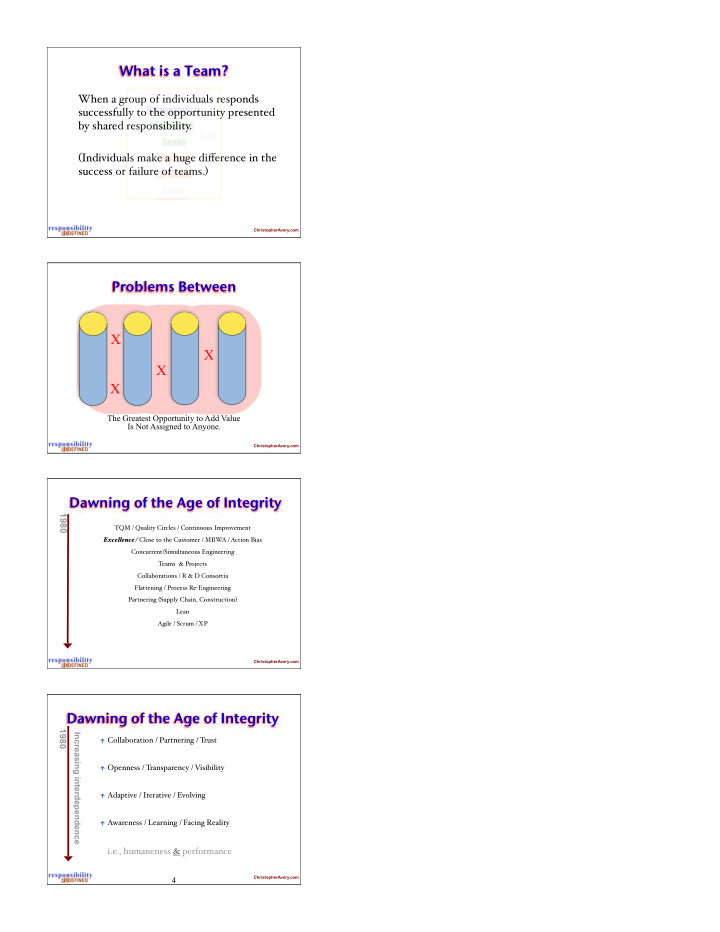



What is a Team? When a group of individuals responds successfully to the opportunity presented by shared responsibility. ( Individuals make a huge di ff erence in the success or failure of teams. ) ChristopherAvery.com Problems Between X X X X The Greatest Opportunity to Add Value Is Not Assigned to Anyone. ChristopherAvery.com Dawning of the Age of Integrity 1980 TQM / Quality Circles / Continuous Improvement Exce lm ence / Close to the Customer / MBWA / Action Bias Concurrent/Simultaneous Engineering Teams & Projects Collaborations / R & D Consortia Flattening / Process Re - Engineering Partnering ( Supply Chain, Construction ) Lean Agile / Scrum / XP ChristopherAvery.com Dawning of the Age of Integrity 1980 Increasing interdependence Collaboration / Partnering / T rust Openness / T ransparency / Visibility Adaptive / Iterative / Evolving Awareness / Learning / Facing Reality i.e., humaneness & performance ChristopherAvery.com 4
4X4 Tic Tac Toe Rules 1. Objective: Maximize your score. 2. Take Turns Scoring 4 in a row = 50 3 in a row = 40 ChristopherAvery.com Responses to Interdependence Isolate or Integrate ChristopherAvery.com Power Economics and Organizing Power Over Power With Power To/By Project/Process Teams Cross-Functional Teams Exchange Integrative Supply Chain Partnering Authority Merger Integration Power Power Power Lean/Agile/Concurrent, etc. Leadership Development Change Management Culture Building from the book Three Faces of Power , Kenneth Boulding ChristopherAvery.com ChristopherAvery.com
Fundamental Problem ACCOUNTABILITY ≠ RESPONSIBILITY 9 ChristopherAvery.com Experts Say “ First Take Responsibility” B u t t h e y d o n ’ t s a y h o w . ChristopherAvery.com Problem-Owning Leverages Problem-Solving Effort Problem-Solving Skill Problem Problem Ownership ChristopherAvery.com Problem-Owning Leverages Problem-Solving m b l e o P r Effort l k i l s n g v i o l - s m l e o b P r Problem Ownership ChristopherAvery.com
How You Respond to a Problem PROBLEM ChristopherAvery.com How You Respond to a Problem OBLIGATION SHAME JUSTIFY LAY BLAME PROBLEM ChristopherAvery.com ChristopherAvery.com How You Respond to a Problem The Responsibility Process™ RESPONSIBILITY OBLIGATION QUIT SHAME No personal JUSTIFY learning occurs here. LAY BLAME PROBLEM DENIAL ChristopherAvery.com
(Re)Definition Re·spon·si·bil·i·ty Owning your power and ability to create , choose , and attract . ChristopherAvery.com Task Functional Adaptive Skills Building Blocks ChristopherAvery.com Keys to Responsibility™ 1. INTENTION 2. AWARENESS 3. CONFRONT ChristopherAvery.com ChristopherAvery.com
Results Awareness The Keys to Responsibility™ unlock: Learning Essential Self - Discipline Fundamental Leadership mind - set Choice Radical Innovation and Execution. Anxiety Rapid T ruth - Telling. What if leaders and fo lm owers : Freedom Owned problems twice as fast? Solved them twice as fast? Authenticity With solutions twice as good? And, Power Felt twice as committed? ChristopherAvery.com Organizational Results • Development team reduced • Chairman notices immediate time to market by 40 % behavior change in senior executives • All new software engineering managers fully functional in • Middle managers resolve half the usual time normally persistent problems in minutes rather than months • CMMI 3 achieved in a Fortune 250 IT department in • Gallup W orkplace Quality record time Scorecard up significantly on 10 of 12 engagement metrics • R&D organization increases participation and decision • Individuals report increased making simultaneously clarity and resourcefulness ChristopherAvery.com Why It Works • Redefines responsibility properly as a natural human process which comes alive in our language. • It’s about an adaptive mindset and cultur e not task ski � s • Honors people and interactions. ChristopherAvery.com Ranked Discriminators of Most and Least Effective Knowledge Teams Trust Goodwill/Cooperation Clarity of Purpose Information Available Inspirational Leadership Group Brainstorming Respect for Individuals Conflict Management Team Learning Autonomy Project Leadership Alignment of Values Climate for Creativity Equipment & Facilities Appropriate Pressure Market/Client Awareness Scientific/Tech. Expertise 0 1 2 3 4 The Great Teams Project (www.Great-Teams.com) ChristopherAvery.com
The Great Teams Project (www.Great-Teams.com) ChristopherAvery.com Knowledge Great-Teams.com Team Trust Effectiveness Dynamics Profile (KTEP) Factor Goodwill & Respect for Correlations Cooperation Individuals Conflict Team Management Brainstorming Processes Creative Team Dialogue Learning Information Sharing Inspirational Leadership Leadership > 0.70 Clarity of Project Purpose Management 0.60 to 0.69 0.55 to 0.59 ChristopherAvery.com Team Orientation Process™ Start 1. Get in the same boat together 2. Align wins 3. Make and keep agreements 4. Find a clear and elevating goal 5. Inventory strengths and honor differences Does the team have direction No and energy? Go! Yes Apply this with me at KnowledgeTeamLeadership.com ChristopherAvery.com Common Task Specification What must we do that is: – bigger than any of us, – requires all of us, and – none of us can claim victory until we are done? Note: this will only be achieved in dialog ChristopherAvery.com
Team Orientation Process™ Start 1. Get in the same boat together 2. Align wins 3. Make and keep agreements 4. Find a clear and elevating goal 5. Inventory strengths and honor differences Does the team have direction No and energy? Go! Yes ChristopherAvery.com Easy Change for Executives Executive What agile practices are mos t session at important for executives? Agile2007 1. Few clear priorities (less is more) 2. Meeting Rhythms (the daily “huddle”, weekly, monthly— more and much better meetings!) 3. Backlog (log the wish-list) ChristopherAvery.com Mastering The Rockefeller Habits • Priorities – Core Values – One-page strategic plan – Organizational alignment • Data Verne Harnish, – transparency Mastering the Rockefeller Habits www.Gazelles.com – truth • Rhythm – Weekly meetings – Daily Huddles ChristopherAvery.com Results with Shared Responsibility Aligning and Re - aligning Engaging Building T rust Motivating Peers Making and Keeping Agreements Goal Setting Decision Making Negotiating Resolving Conflict Feedback and Di ffi cult Behavior ChristopherAvery.com 32
Details • get my slides later today at www.ChristopherAvery.com/blog • Check out www.KnowledgeTeamLeadership.com • Start practicing ChristopherAvery.com VISION I see the Responsibility Process poster hanging in every o ffi ce, classroom, kitchen, and church in the world. 34
Recommend
More recommend